 Image search results - "birth" Image search results - "birth" |

Lord Ishida Mitsunari was born in 1560 in Ishida village in Nagahama, Shiga Pref. You can see the site of his birthplace by bus from Nagahama Station. Get off at the Ishida bus stop. MAPHis birthplace and former residence have monuments dedicated to this fallen but revered leader of the Western Forces which lost to Tokugawa Ieyasu at the Battle of Sekigahara in 1600. He was a protégé and main samurai retainer of Toyotomi Hideyoshi.
|
|

Little stone marker and shrine next to the bus stop.
|
|

Ishida Mitsunari is most famous for the Battle of Sekigahara in 1600 when he unsuccessfully led his Western Forces against Tokugawa Ieyasu's Eastern Forces
|
|

Steel sculpture depicting Ishida Mitsunari giving tea to Toyotomi Hideyoshi. Ishida-cho, Nagahama, Shiga Pref.
|
|

Steel sculpture depicting Ishida Mitsunari giving tea to Toyotomi Hideyoshi. The road on the left goes to the site of his former residence.
|
|
|

Monument and bus stop
|
|

Road on left goes to Ishida's former residence.
|
|

Road to Kan'onji temple and marker of Ishida Mitsunari's estate
|
|

Marker of Ishida Mitsunari's estate
|
|

Site of Ishida Mitsunari's former residence. 石田三成屋敷跡
|
|

The property is now occupied by the Ishida Kaikan public hall and monuments. 石田三成屋敷跡 石田会館
|
|

Monument marking Ishida Mitsunari's former residence.
|
|

Monument marking Ishida Mitsunari's former residence.
|
|

Public hall
|
|

Inside public hall
|
|

Monuments on the property
|
|

Stone monument for Ishida Mitsunari Birthplace 石田三成公出生地
|
|

Statue of Ishida Mitsunari at his former residence in Nagahama.
|
|

Statue of Ishida Mitsunari
|
|
|
|
|
|

Poem about Ishida Mitsunari
|
|

Scenery behind the public hall.
|
|

Behind the public hall.
|
|

Poem about the Battle of Sekigahara.
|
|

Guide map to places in the area related to Ishida Mitsunari.
|
|

Nearby Hachiman Shrine.
|
|

Hachiman Shrine torii
|
|

Hachiman Shrine is next to the Ishida Mitsunari memorial.
|
|

Ishida Jinja Shrine
|
|

Ishida Jinja Shrine
|
|

Ishida Shrine
|
|

Entrance to Ishida Shrine 石田神社 供養塔
|
|
|

Ishida Mitsunari Memorial
|
|
|
|

Ishida Mitsunari Memorial 石田三成供養塔
|
|
|
|

Ishida Mitsunari Memorial
|
|

Poem
|
|
|
|
|
|

Cycling road sign near bus stop.
|
|

Like most major Buddhist temples, Sensoji temple in Asakusa holds its Hanamatsuri to mark Buddha's birthday on April 8. Hana Matsuri sign at Kaminarimon Gate.
|
|

A symbol of Hanamatsuri (literally "flower festival") is the white elephant which is paraded around. This one stands ready at Kaminarimon Gate. It has a baby Buddha statue on top.
|
|

When the Buddha was born, he walked seven steps and said, "I am my own Lord through Heaven and Earth," and pointed one hand to Heaven and the other to Earth.
|
|

Children from the local kindergarten walk toward Kaminarimon Gate from where they will pull the white elephant.
|
|

Every April 8, if it's a nice day, I try to visit a different temple in Japan to see Hanamatsuri. This year I decided to see it in Asakusa.
|
|

Sensoji temple was renovating its roof so it is covered with scaffolding (painted with a gold dragon). Out front is the Hanami-do where you can pour sweet tea over the baby Buddha.
|
|

People crowd around the flower-decorated Hanami-do, the little hall with the baby Buddha.
|
|
|

People pour sweet tea over the baby Buddha. He points one finger to Heaven. 花御堂
|
|

Sweet tea is poured over a statue of a baby buddha. According to legend, sweet rain (or perfumed water) fell when the Buddha was born.
|
|

Inside Sensoji temple was another Hanami-do with a baby Buddha. 花御堂
|
|

Anyone can pour the sweet tea over the baby Buddha for free.
|
|

The little Hanamatsuri parade went through Nakamise and arrived at Sensoji with the white elephant in tow.
|
|

Asakusa Hana Matsuri 花まつり
|
|

In front of Sensoji temple, they held a Hana Matsuri ceremony with the kindergarten kids.
|
|

They sang a few songs. Their parents toting video camcorders recorded the event.
|
|
|

Asakusa: White elephant is usually present during Hanamatsuri. On the day before the Buddha's mother Queen Maya gave birth, she dreamed that a white elephant entered her womb.
|
|
|

Kids pour sweet tea over the baby Buddha during the Hanamatsuri ceremony.
|
|
|

Hanamatsuri at Sensoji temple in Asakusa.
|
|

Baby Buddha on the white elephant.
|
|

White elephant and the pagoda at Sensoji temple, Asakusa on Buddha's birthday called Hanamatsuri.
|
|

After the ceremony, they served free sweet tea. 甘茶
|
|

Ama-cha sweet tea for everyone. 甘茶
|
|

An extra treat was free flowers (orchids). They gave out a large number of these flowers.
|
|
|

The flowers were made in Thailand.
|
|

Pretty orchid. It had a water capsule at the end of the stem. At the top were buds which later bloomed. This flower lasted me well over a month before it withered.
|
|

Hanamatsuri sign
|
|

About Hanamatsuri in Japanese.
|
|

Iga-Ueno's Ueno Park includes this beautiful building called the Haisei-den (俳聖殿), a hall dedicated to Haiku poet Matsuo Basho who was from Iga-Ueno.
|
|

A short walk from Iga-Ueno Castle and almost next to the ninja house, the Haisei-den was built in 1942 to mark the 300th anniversary of Basho's birth.
|
|

The building was designed by architect Ito Chota (1867-1954) (伊東 忠太) who designed numerous shrine and temple buildings in the 1920s and '30s, including Tsukiji Hongwanji temple in Tokyo.
|
|

The Haisei-den was designed to look like Basho in travel clothing. The top roof resembles a hat, and the lower roof resembles his straw raincoat. Cherry blossoms were in bloom.
|
|
|

Haisei-den and wisteria in bloom. The Basho Matsuri Festival is a poetry reading held here on Oct. 12.
|
|

Inside the Haisei-den is a ceramic statue of Basho.
|
|

Iga-yaki ceramic statue of Basho inside the Haisei-den.
|
|

A short walk from Ueno Park is the Basho Oseika (芭蕉翁生家) or Basho's childhood home. Iga is the birthplace of Matsuo Basho (1644-1694), and the house where he grew up in still stands.
|
|

The house is open to the public as a tourist attraction (admission 300 yen). The house was rebuilt after it being damaged by a large earthquake in 1854.
|
|

Room inside Basho's childhood home.
|
|
|

Small door to the kitchen. People must have been pretty short then.
|
|

Kitchen area with a well on the left and stoves toward the right.
|
|
|

Water well
|
|

Kitchen stoves
|
|
|
|

Toilets and bath
|
|

Urinal
|
|
|

The back of the house is Basho's study called Chogetsuken (釣月軒) where he wrote the Kai-ooi (貝おほい) series of poems.
|
|

Inside the Chogetsuken study. 釣月軒
|
|

The study is a very simple, yet aesthetic and meditative-looking room.
|
|
|

Statue of Basho at Ueno-shi Station.
|
|

Dec. 23, 2004 at 8:30 am: Across the street from the Imperial Palace. Dec. 23 and Jan. 2 are the only two days when the general public is allowed to enter the palace to greet the Emperor and his family.A visit to the Imperial Palace by the general public is called "ippan sanga" in Japanese (一般参賀).
On the Emperor's birthday, the Imperial Palace can be entered only at certain locations. You have to find out where they are and stand in line there. Just go near the Imperial Palace and ask a policeman where you can stand in line. You otherwise cannot enter the grounds. The huge, graveled plaza where you can see Nijubashi Bridge is closed off by police.
While standing in line here, we received free paper Japanese flags.
|
|
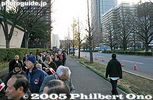
Line behind
|
|

8:37 am: We crossed the street to enter Imperial Palace grounds
|
|
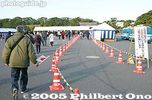
Bag checkpoint ahead. They inspected all our bags. Note that they do not allow any drinks (not even water) to be taken into the palace. You will have to dump it in the trash can they provide.
|
|
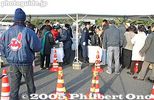
8:40 am: Bag check
|
|
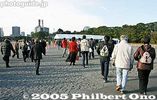
Body inspection up ahead. They frisked the body and also used a metal detector as well. I had to explain that the hump in my pants pocket was a wallet and cell phone. He believed me since I have an honest-looking face.
|
|

8:43 am: Passed body check and walking to waiting line. After seeing these coned lanes, I was glad that I went early. I don't know if all these lanes were later filled with people, but probably yes.
|
|

Lining up in line 1
|
|

Approaching the entrance near Nijubashi Bridge
|
|

9:20 am: Long line behind. If it's a sunny day, it's sunburn time. We waited here for over 30 min.
|
|

Merging with another line up ahead
|
|
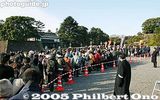
9:28 am: Finally walking toward Nijubashi Bridge. There were a lot of men in trench coats gazing at the crowd.
|
|

Getting closer to the bridge
|
|

Nijubashi Bridge straight ahead!
|
|

9:31 am: Crossing the famous Nijubashi Bridge. It turned out to be a completely modern bridge, no sqeaking or anything. 二重橋
|
|
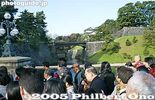
Right view from Nijubashi Bridge. In the distance, you can see another parallel bridge which leads directly into the inner grounds of the palace. We will cross that bridge too. There is also the castle-like structure called the Fushimi Turret.
|
|

Left view from Nijubashi Bridge. Everyone knows what the Nijubashi Bridge looks like from outside. Finally, we see what it looks like from the bridge. 二重橋
|
|
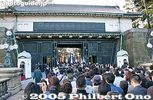
On Nijubashi Bridge heading for the Seimon Gate. 正門
|
|

Main gate
|
|
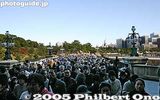
9:33 am: Behind us on Nijubashi Bridge. 二重橋
|
|

Walking toward the second bridge
|
|
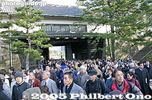
Out of the main gate. Everything was very orderly, no pushing nor shoving.
|
|

9:35 am: Walking toward the second bridge. We walked up a slight slope to reach the second, parallel bridge. The Fushimi Turret is in the background.
|
|

Fushimi Turret. This view of the turret can only be had when you cross the bridge. I never knew what it really looked like until this day. 伏見櫓
|
|
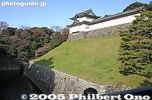
Fushimi Turret. This view of the turret can only be had when you cross the bridge. I never knew what it really looked like until this day. 伏見櫓
|
|

9:38 am: Crossing the second bridge. The first Nijubashi Bridge, which we crossed first, is in the distance. Nijubashi means double bridge. 二重橋
|
|
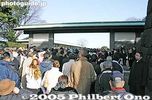
Nakamon Gate to Imperial Palace 中門
|
|

9:40 am: Inside the Imperial Palace. This is called the Kyudentotei. It is a large plaza in front of the palace.
|
|

Kyuden Totei plaza
|
|
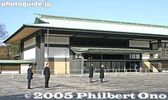
Entrance for state guests. This is where heads of state and other royalty enter this building.
|
|

Filling up the plaza
|
|

The center is filled up first. The center is in front of the balcony where the Imperial family will appear. Thus, the earlier you go, the better chance of you standing in front of the balcony.
|
|
|
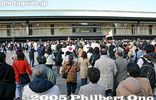
Good location
|
|

9:43 am: Almost front and center
|
|

People behind fill up the rest of the plaza
|
|

Behind us. At the very rear below the trees, there is a slightly elevated platform where the news media can take photos. You can see many tripods set up. That's how they are able to photograph the Emperor with the flags waving well below the balcony.
|
|
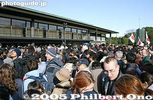
Filled on our right
|
|

9:57 am: Filled on our left. The entire place was full by 10 am. Quite a few foreigners were present as well. Rightists with large flags were also there.
|
|
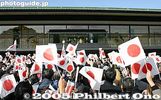
10:20 am: The Emperor and Empress appear right on time on his birthday. As soon as they appeared, people waved paper flags and cheered "banzai!" Also see the video at YouTube.It was an amazing spectacle. I always saw it on TV, but this was the first time I saw it in person. I wish I went when Emperor Hirohito was still living.
From left to right is Princess Nori, the Crown Prince, the Emperor, the Empress, and Prince and Princess Akishino. Crown Princess Masako did not appear due to illness.
I also once used this shot for the cover photo on my home page.
|
|

10:22 am: The Emperor speaks. When the Emperor spoke, the crowd immediately fell silent and all the flags stopped waving. He spoke for only about a minute, thanking us for celebrating his birthday and mentioning this past year's numerous natural disasAfter he finished, everyone waved the flags again and cheered.
|
|
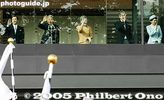
10:23 am: They wave to the crowd again. From left to right is the Crown Prince, the Emperor, the Empress, and Prince and Princess Akishino.It was very difficult to get a good shot of them since so many flags were in the way. I had to hold the camera overhead above the flags and shoot almost blindly with my telephoto lens. Luckily, I managed to get a few decent closeup shots.
|
|
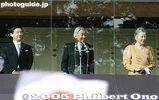
The Crown Prince, the Emperor, and the Empress on the Emperor's Birthday. They were on the balcony for a whole THREE minutes. I thought they would stay there for at least 10 min. Barely had time to mount my telephoto lens.
|
|

10:24 am: After 3 min. on the balcony, they were gone. We waited almost 2 hours for a 3-min. appearance. But I think it's something you should do at least once while in Japan.
|
|
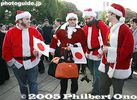
Even Santa Claus came (from Finland??). I'm told that they might be Finns. (Santa is from Finland.)
|
|

10:25 am: Clearing out the crowd. We were promptly herded to the exit to make room for the next horde of people waiting to see the Emperor who appeared two more times that day.
|
|
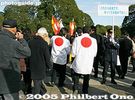
Japan fans. The sign says, "Downward slope ahead, walk slowly." It's only about 10:30 am, so it's a good time to walk around the Imperial Palace and the East Gardens. Although no flowers are in bloom, you might see autumn leaves.For more info about the Imperial Family and visiting the palace, see the Imperial Household Agency's Web site.
|
|
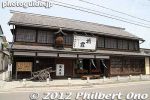
Poet Takamura Chieko's birth home. 高村 智恵子
|
|
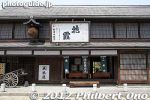
Poet Takamura Chieko's birth home. 高村 智恵子
|
|
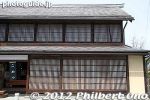
Poet Takamura Chieko's birth home. 高村 智恵子
|
|
|
|
|
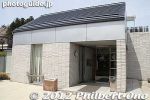
Small modern museum next to Poet Takamura Chieko's birth home. Exhibits art works by her and her husband Takamura Kotaro.
|
|
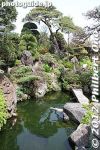
Japanese garden at poet Takamura Chieko's birth home. 高村 智恵子
|
|
|
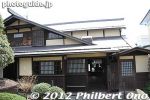
Poet Takamura Chieko's birth home.
|
|
|
|
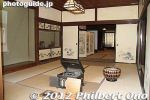
Inside poet Takamura Chieko's birth home.
|
|
|
|
|
|
|
|
|
|
|
|
|
|
|
|
|
|
|
|
|
|
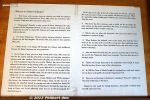
About Poet Takamura Chieko's birth home. 高村 智恵子
|
|
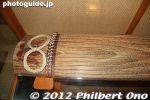
Samisen played by Chieko.
|
|
|
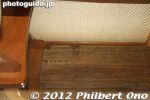
Signature under the samisen.
|
|
|
|
|
|
|
|
|
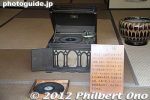
After visiting this home, I went to Nihonmatsu Castle (photos here).
|
|
|
|
|
|